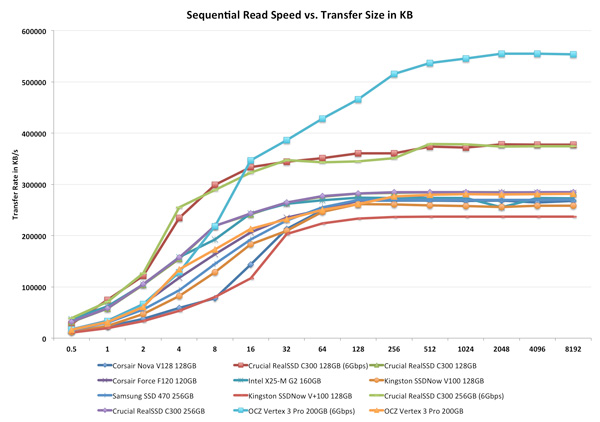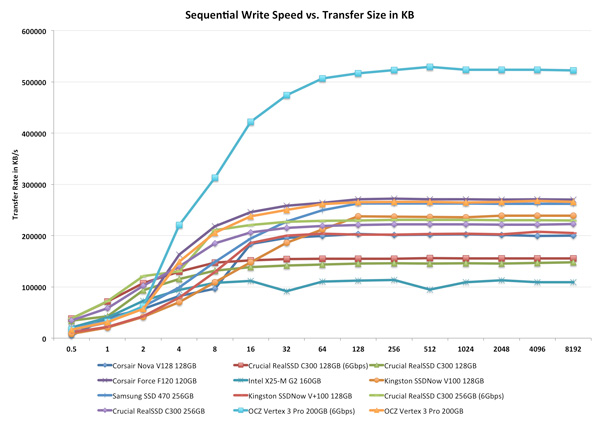OCZ Vertex 3 Pro Preview: The First SF-2500 SSD
by Anand Lal Shimpi on February 17, 2011 3:01 AM ESTPerformance vs. Transfer Size
All of our Iometer sequential tests happen at a queue depth of 1, which is indicative of a light desktop workload. It isn't too far fetched to see much higher queue depths on the desktop. The performance of these SSDs also greatly varies based on the size of the transfer. For this next test we turn to ATTO and run a sequential write over a 2GB span of LBAs at a queue depth of 4 and varying the size of the transfers.
On a 6Gbps SATA port the Vertex 3 Pro is unstoppable. For transfer sizes below 16KB it's actually a bit average, and definitely slower than the RealSSD C300. But once you hit 16KB and above, the performance is earth shattering. The gap at 128KB isn't even as big as it gets, we don't see leveling off of performance until 2048KB transfers.
The 3Gbps performance is pretty unimpressive. In fact, the Vertex 3 Pro actually comes in a bit slower than the SF-1200 based Corsair Force F120. If you're going to get the most out of this drive you had better have a good 6Gbps controller.
ATTO's writes are fully compressible, indicative of the sort of performance you'd get on applications/libraries/user data and not highly compressed multimedia files. Here the advantage is just hilarious. By the 8KB mark the Vertex 3 Pro is already faster than everything else, but by 128KB the gap is more of a chasm separating the 6Gbps Vertex 3 Pro from its competitors.
Over a 3Gbps interface the Vertex 3 Pro once again does well but still doesn't really differentiate itself from the SF-1200 based Force F120. Real world performance is probably a bit higher as most transfers aren't perfectly compressible, but again if you don't have a good 6Gbps interface (think Intel 6-series or AMD 8-series) then you probably should wait and upgrade your motherboard first.












144 Comments
View All Comments
eva2000 - Thursday, February 17, 2011 - link
Thanks for the review, curious why the 256GB Crucial RealSSD C300 only included in some benchmarks and not others ?Anand Lal Shimpi - Thursday, February 17, 2011 - link
That's simply a data entry issue, I'll get it fixed :)Take care,
Anand
therealnickdanger - Thursday, February 17, 2011 - link
Also, I'm curious as to why none of the REVO benchmarks are included? On the one hand, I understand how niche PCIe drives may be, but on the other, they can offer significant performance over both SATA 3Gbps and 6Gbps drives. It would be nice to see the new Heavy and Light benchmarks applied to those as well.ludikraut - Thursday, February 17, 2011 - link
+1 on including REVO drive results in the drive comparisons.markjx1 - Thursday, February 17, 2011 - link
because REVO drives are garbage. they're nothing more than a bunch of vertex2's slapped onto a board with a cheap Silicone Image controller that has a PCI-X to PCIe bridge. Resale value on REVO is crap and if one of the drives dies, you have a nice paperweight.bji - Thursday, February 17, 2011 - link
Your own personal opinion on the drives are not a reason to disclude them from the review.therealnickdanger - Thursday, February 17, 2011 - link
Garbage that can pull down 800MB/s...? Go away, troll. For users without SATA 6Gbps, it's a very practical solution to achieve huge speed. In fact, even people WITH SATA 6Gbps would get a boost. The cost/GB is even under $2 for some of the REVOs, making them a reasonable alternative.Anand Lal Shimpi - Thursday, February 17, 2011 - link
All graphs should now have the 256GB C300 in them :)Breogan - Thursday, February 17, 2011 - link
Is the data in the Incompressible Write Speed Test mixed for the SF2500 drive or does it perform actually worse after trim?. It seems weird to me that a dirty drive performs as if it was stock and the trim actually worsens its perfomance.Anand Lal Shimpi - Thursday, February 17, 2011 - link
It's not TRIM that is making the drive slower, it's the next write pass that's actually pushing the drive into a lower performance state as there's more garbage collection/cleaning that's going on. If I hadn't TRIMed and just ran another pass of the AS-SSD test you'd see the same number.Take care,
Anand